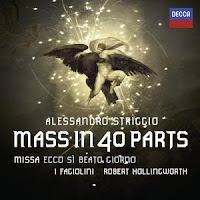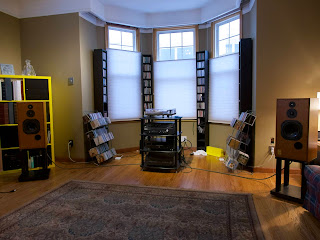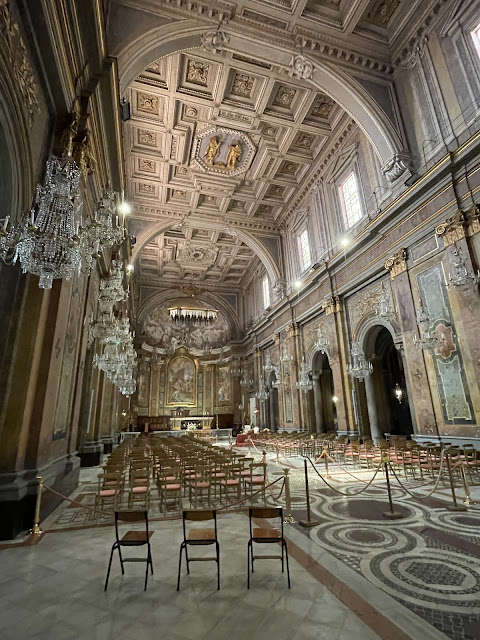Christmas Shopping
Not long ago, I had the chance to visit my favourite CD store. Did you say "CD" store? Yes. Even though many stores have closed some specialized ones are still around, and the CD shows no real sign of disappearing. The same thing seems to be true with 35mm film. I was talking to a salesman at at a downtown camera store. He told me that some young people in college are taking an interest in film. One benefit is that you really do need to learn the mechanics of good photographing techniques when you use film.
A benefit of having CD's around is that some rather specialized music can be recorded in a high quality manner. The media world has made recording very democratic and the internet has allowed wide distribution, but the effect on quality can also be noticed. The CD still provides a stable format for the storing and playing of recordings.
My intention at the store was do some Christmas shopping with the possible side effect that I might pick up a few recordings for myself. Of course, I can't tell you yet what music I purchased as gifts, but I spent just as much on recordings that I acquired for myself.
 The most remarkable and I think significant recording is a Mass written in 40 parts -- yes 40 parts, by Striggio. It is a new Decca recording and is excellent and includes a DVD with some 5.1 tracks. For those who sing in choirs SATB is usually difficult enough. Striggio's music for the Catholic Church elicited an intentional response by the English Elizabethan composer Thomas Tallis. Tallis' piece is better known: Spem in Alium.
The most remarkable and I think significant recording is a Mass written in 40 parts -- yes 40 parts, by Striggio. It is a new Decca recording and is excellent and includes a DVD with some 5.1 tracks. For those who sing in choirs SATB is usually difficult enough. Striggio's music for the Catholic Church elicited an intentional response by the English Elizabethan composer Thomas Tallis. Tallis' piece is better known: Spem in Alium.
Recently I was in the Holy Land on a pilgrimage. I picked up one CD of folk music there, but when I came home I wanted some Klesmer music and found a nice disc. The most bizarre purchase is an "original instruments" rendering of some of the texts in German of the Carmina Burana. This obscure manuscript would not be known except for a 20th century composition by Carl Orff using some of the ancient texts. The chorus that begins and ends the piece has appeared in beer commercials. It will take me a while to feel I'm a little more inside this ancient music.
Both the 40-part disc and this disc show how complex medieval and Renaissance music is. Intellectually and spiritually it is good to be stretched. In a diverse world we all need it. This music shows that there are rewards in such exploits.
 I also picked up a couple of classic Broadway soundtracks: My Fair Lady, and Man of La Mancha. The first is a rendering on the George Bernard Shaw play, Pygmalion and the latter a take on the epic novel of Don Quixote by Cervantes. The first story was meant to address issues of class and social standing in British society. Although obviously it is written for another time, it still has resonance. The second is almost the national story of Spain. It raises questions of idealism and the worthiness of living a life of seeking to right the wrongs of the world. In the end, Don Quixote appears to be an old fool, but he ends up having a profound effect. This show was first performed in the mid sixties. Each show has some really well-known songs.
I also picked up a couple of classic Broadway soundtracks: My Fair Lady, and Man of La Mancha. The first is a rendering on the George Bernard Shaw play, Pygmalion and the latter a take on the epic novel of Don Quixote by Cervantes. The first story was meant to address issues of class and social standing in British society. Although obviously it is written for another time, it still has resonance. The second is almost the national story of Spain. It raises questions of idealism and the worthiness of living a life of seeking to right the wrongs of the world. In the end, Don Quixote appears to be an old fool, but he ends up having a profound effect. This show was first performed in the mid sixties. Each show has some really well-known songs.
I rounded out my purchases with a disc of sea shanties. My classical interests were fed by a new recording by Thomas Hampson of the song cycle of Gustav Mahler, Das Knaben Wunderhorn (The Youth's Magic Horn) with a chamber orchestra consisting of players from the Vienna Philharmonic. Wow. Biggest concentration of Stradivarius violins in the world. Cool.
A benefit of having CD's around is that some rather specialized music can be recorded in a high quality manner. The media world has made recording very democratic and the internet has allowed wide distribution, but the effect on quality can also be noticed. The CD still provides a stable format for the storing and playing of recordings.
My intention at the store was do some Christmas shopping with the possible side effect that I might pick up a few recordings for myself. Of course, I can't tell you yet what music I purchased as gifts, but I spent just as much on recordings that I acquired for myself.
 The most remarkable and I think significant recording is a Mass written in 40 parts -- yes 40 parts, by Striggio. It is a new Decca recording and is excellent and includes a DVD with some 5.1 tracks. For those who sing in choirs SATB is usually difficult enough. Striggio's music for the Catholic Church elicited an intentional response by the English Elizabethan composer Thomas Tallis. Tallis' piece is better known: Spem in Alium.
The most remarkable and I think significant recording is a Mass written in 40 parts -- yes 40 parts, by Striggio. It is a new Decca recording and is excellent and includes a DVD with some 5.1 tracks. For those who sing in choirs SATB is usually difficult enough. Striggio's music for the Catholic Church elicited an intentional response by the English Elizabethan composer Thomas Tallis. Tallis' piece is better known: Spem in Alium. Recently I was in the Holy Land on a pilgrimage. I picked up one CD of folk music there, but when I came home I wanted some Klesmer music and found a nice disc. The most bizarre purchase is an "original instruments" rendering of some of the texts in German of the Carmina Burana. This obscure manuscript would not be known except for a 20th century composition by Carl Orff using some of the ancient texts. The chorus that begins and ends the piece has appeared in beer commercials. It will take me a while to feel I'm a little more inside this ancient music.
Both the 40-part disc and this disc show how complex medieval and Renaissance music is. Intellectually and spiritually it is good to be stretched. In a diverse world we all need it. This music shows that there are rewards in such exploits.
 I also picked up a couple of classic Broadway soundtracks: My Fair Lady, and Man of La Mancha. The first is a rendering on the George Bernard Shaw play, Pygmalion and the latter a take on the epic novel of Don Quixote by Cervantes. The first story was meant to address issues of class and social standing in British society. Although obviously it is written for another time, it still has resonance. The second is almost the national story of Spain. It raises questions of idealism and the worthiness of living a life of seeking to right the wrongs of the world. In the end, Don Quixote appears to be an old fool, but he ends up having a profound effect. This show was first performed in the mid sixties. Each show has some really well-known songs.
I also picked up a couple of classic Broadway soundtracks: My Fair Lady, and Man of La Mancha. The first is a rendering on the George Bernard Shaw play, Pygmalion and the latter a take on the epic novel of Don Quixote by Cervantes. The first story was meant to address issues of class and social standing in British society. Although obviously it is written for another time, it still has resonance. The second is almost the national story of Spain. It raises questions of idealism and the worthiness of living a life of seeking to right the wrongs of the world. In the end, Don Quixote appears to be an old fool, but he ends up having a profound effect. This show was first performed in the mid sixties. Each show has some really well-known songs. I rounded out my purchases with a disc of sea shanties. My classical interests were fed by a new recording by Thomas Hampson of the song cycle of Gustav Mahler, Das Knaben Wunderhorn (The Youth's Magic Horn) with a chamber orchestra consisting of players from the Vienna Philharmonic. Wow. Biggest concentration of Stradivarius violins in the world. Cool.

